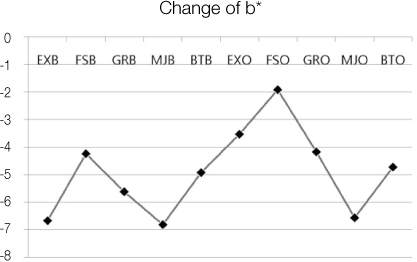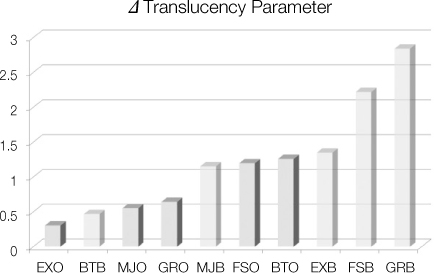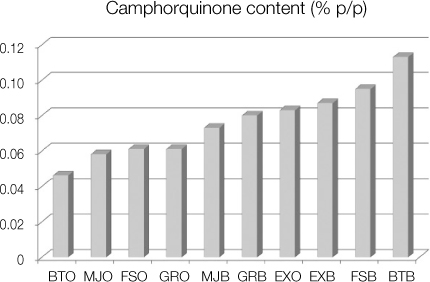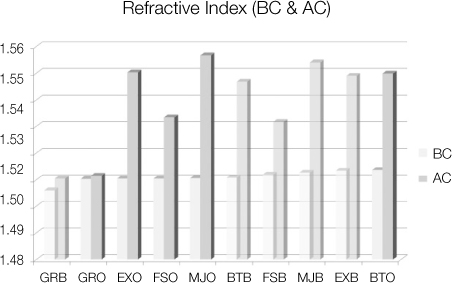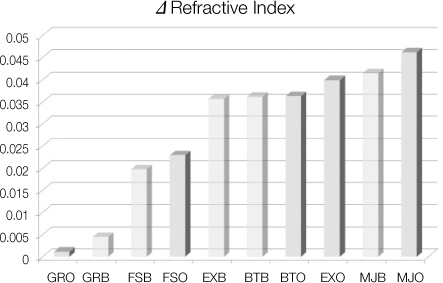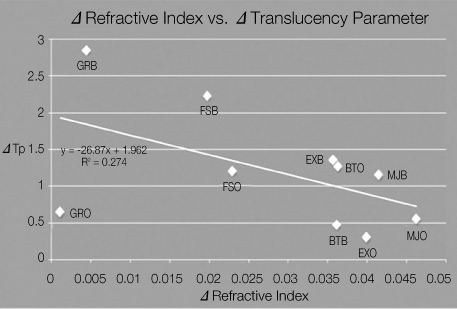J Korean Acad Conserv Dent.
2011 May;36(3):219-230. 10.5395/JKACD.2011.36.3.219.
Optical characteristics of resin composite before and after polymerization
- Affiliations
-
- 1Department of Conservative Dentistry, Graduate of Kyung Hee University, Seoul, Korea. choikkyu@khu.ac.kr
- KMID: 1986686
- DOI: http://doi.org/10.5395/JKACD.2011.36.3.219
Abstract
OBJECTIVES
The aim of this study was to evaluate the optical characteristics such as color and translucency changes before and after light curing, to quantify the CQ and to measure refractive indices of body and opaque shade of resin composites materials.
MATERIALS AND METHODS
Resin composites used in this study were A2 body and A2 opaque shade of Esthet-X, Filtek supreme, Gradia Direct, Clearfil Majesty and Beautifil?? Color and translucency changes before and after light curing were evaluated by colorimeter, the CQ was quantified by GC-MS and refractive index changes were measured by spectroscopic ellipsometer.
RESULTS
Translucency parameter (TP) was significantly increased after curing. The CQ content of body shades are higher than that of opaque shades in all resin composites. Refractive index increased after polymerization in all materials and significant difference in Deltarefractive index was found between body and opaque shade (significance level 0.05).
CONCLUSIONS
For an accurate shade match, direct shade matching of resin composite should be performed by using the cured material.
Keyword
Figure
Reference
-
1. Yap AU, Tan KB, Bhole S. Comparison of aesthetic properties of tooth-colored restorative materials. Oper Dent. 1997. 22:167–172.2. Park SJ, Lee HY, Na MY, Chang HS, Hwang YC, Oh WM, Hwang IN. The evaluation of color and color difference according to the layering placement of Incisal shade composites on the body composites of the indirect resin restoration. J Korean Acad Conserv Dent. 2011. 36:37–49.
Article3. Yap AU, Bhole S, Tan KB. Shade match of tooth-colored restorative materials based on a commercial shade guide. Quintessence Int. 1995. 26:697–702.4. Kim HS, Um CM. Color differences between resin composites and shade guides. Quintessence Int. 1996. 27:559–567.5. Park SJ, Hwang YC, Oh WM, Hwang IN. Opacity and mashing effect of the opaque shade composite resins. J Korean Acad Conserv Dent. 2007. 32:356–364.
Article6. Sidhu SK, Ikeda T, Omata Y, Fujita M, Sano H. Change of color and translucency by light curing in resin composites. Oper Dent. 2006. 31:598–603.
Article7. Seghi RR, Gritz MD, Kim J. Colorimetric changes in composites resulting from visible-light-initiated polymerization. Dent Mater. 1990. 6:133–137.
Article8. Cho KJ, Park SJ, Cho HG, Kim DJ, Hwang YC, Oh WM, Hwang IN. Influence of the surface roughness on translucency and surface color of the dental composite resins. J Korean Acad Conserv Dent. 2006. 31:312–322.
Article9. Ikeda T, Nakanishi A, Yamamoto T, Sano H. Color differences and color changes in Vita Shade tooth-colored restorative materials. Am J Dent. 2003. 16:381–384.10. Ikeda T, Murata Y, Sano H. Translucency of opaqueshade resin composites. Am J Dent. 2004. 17:127–130.11. Ikeda T, Sidhu SK, Omata Y, Fujita M, Sano H. Colour and translucency of opaque-shades and bodyshades of resin composites. Eur J Oral Sci. 2005. 113:170–173.
Article12. Kamishima N, Ikeda T, Sano H. Color and translucency of resin composites for layering techniques. Dent Mater J. 2005. 24:428–432.
Article13. Alvim HH, Alecio AC, Vasconcellos WA, Furlan M, de Oliveira JE, Saad JR. Analysis of camphorquinone in composite resins as a function of shade. Dent Mater. 2007. 23:1245–1249.
Article14. Peutzfeldt A, Asmussen E. Hardness of restorative resins: effect of camphorquinone, amine, and inhibitor. Acta Odontol Scand. 1989. 47:229–231.
Article15. Rueggeberg FA, Ergle JW, Lockwood PE. Effect of photoinitiator level on properties of a light-cured and postcure heated model resin system. Dent Mater. 1997. 13:360–364.
Article16. Yoshida K, Greener EH. Effect of photoinitiator on degree of conversion of unfilled light-cured resin. J Dent. 1994. 22:296–299.
Article17. Yoshida K, Greener EH. Effects of two amine reducing agents on the degree of conversion and physical properties of an unfilled light-cured resin. Dent Mater. 1993. 9:246–251.
Article18. Park YJ, Chae KH, Rawls HR. Development of a new photoinitiation system for dental light-cure composite resins. Dent Mater. 1999. 15:120–127.
Article19. Johnston WM, Ma T, Kienle BH. Translucency parameter of colorants for maxillofacial prostheses. Int J Prosthodont. 1995. 8:79–86.20. Johnston WM, Reisbick MH. Color and translucency changes during and after curing of esthetic restorative materials. Dent Mater. 1997. 13:89–97.
Article21. Ruyter IE, Nilner K, Moller B. Color stability of dental composite resin materials for crown and bridge veneers. Dent Mater. 1987. 3:246–251.
Article22. Swift EJ Jr, Hammel SA, Lund PS. Colorimetric evaluation of vita shade resin composites. Int J Prosthodont. 1994. 7:356–361.23. Powers JM, Yeh CL, Miyagawa Y. Optical properties of composites of selected shades in white light. J Oral Rehabil. 1983. 10:319–324.
Article24. Kawaguchi M, Fukushima T, Miyazaki K. The relationship between cure depth and transmission coefficient of visible-light-activated resin composites. J Dent Res. 1994. 73:516–521.
Article25. Gross MD, Moser JB. A colorimetric study of coffee and tea staining of four composite resins. J Oral Rehabil. 1977. 4:311–322.
Article26. Moin Jan C, Nomura Y, Urabe H, Okazaki M, Shintani H. The relationship between leachability of polymerization initiator and degree of conversion of visible light-cured resin. J Biomed Mater Res. 2001. 58:42–46.
Article27. Michelsen VB, Lygre H, Skålevik R, Tveit AB, Solheim E. Identification of organic eluates from four polymer-based dental filling materials. Eur J Oral Sci. 2003. 111:263–271.
Article28. Shintani H, Inoue T, Yamaki M. Analysis of camphorquinone in visible light-cured composite resins. Dent Mater. 1985. 1:124–126.
Article29. Taira M, Urabe H, Hirose T, Wakasa K, Yamaki M. Analysis of photo-initiators in visible-light-cured dental composite resins. J Dent Res. 1988. 67:24–28.
Article30. Teshima W, Nomura Y, Tanaka N, Urabe H, Okazaki M, Nahara Y. ESR study of camphorquinone/amine photoinitiator systems using blue light-emitting diodes. Biomaterials. 2003. 24:2097–2103.
Article31. Neumann MG, Miranda WG Jr, Schmitt CC, Rueggeberg FA, Correa IC. Molar extinction coefficients and the photon absorption efficiency of dental photoinitiators and light curing units. J Dent. 2005. 33:525–532.
Article32. Inokoshi S, Burrow MF, Kataumi M, Yamada T, Takatsu T. Opacity and color changes of tooth-colored restorative materials. Oper Dent. 1996. 21:73–80.33. Campbell PM, Johnston WM, O'Brien WJ. Light scattering and gloss of an experimental quartz-filled composite. J Dent Res. 1986. 65:892–894.
Article34. Arimoto A, Nakajima M, Hosaka K, Nishimura K, Ikeda M, Foxton RM, Tagami J. Translucency, opalescence and light transmission characteristics of light-cured resin composites. Dent Mater. 2010. 26:1090–1097.
Article35. Lehtinen J, Laurila T, Lassila LV, Vallittu PK, Räty J, Hernberg R. Optical characterization of bisphenol-A-glycidyldimethacrylate-triethyleneglycoldimethacrylate (BisGMA/TEGDMA) monomers and copolymer. Dent Mater. 2008. 24:1324–1328.
Article36. Emami N, Sjödahl M, Söderholm KJ. How filler properties, filler fraction, sample thickness and light source affect light attenuation in particulate filled resin composites. Dent Mater. 2005. 21:721–730.
Article37. Shortall AC, Palin WM, Burtscher P. Refractive index mismatch and monomer reactivity influence composite curing depth. J Dent Res. 2008. 87:84–88.
Article38. Westland S. Review of the CIE system of colorimetry and its use in dentistry. J Esthet Restor Dent. 2003. 15:S5–S12.
Article39. Howard B, Wilson ND, Newman SM, Pfeifer CS, Stansbury JW. Relationships between conversion, temperature and optical properties during composite photopolymerization. Acta Biomater. 2010. 6:2053–2059.
Article
- Full Text Links
- Actions
-
Cited
- CITED
-
- Close
- Share
- Similar articles
-
- Development of anticariogenic composite resin
- Evaluation of polymerization shrinkage stress in silorane-based composites
- A Study Of Surface Roughness Of Composite Resin
- Evaluation of polymerization ability of resin-based materials used for teeth splinting
- Effect of biscover on the marginal microleakage of composite resin restoration



